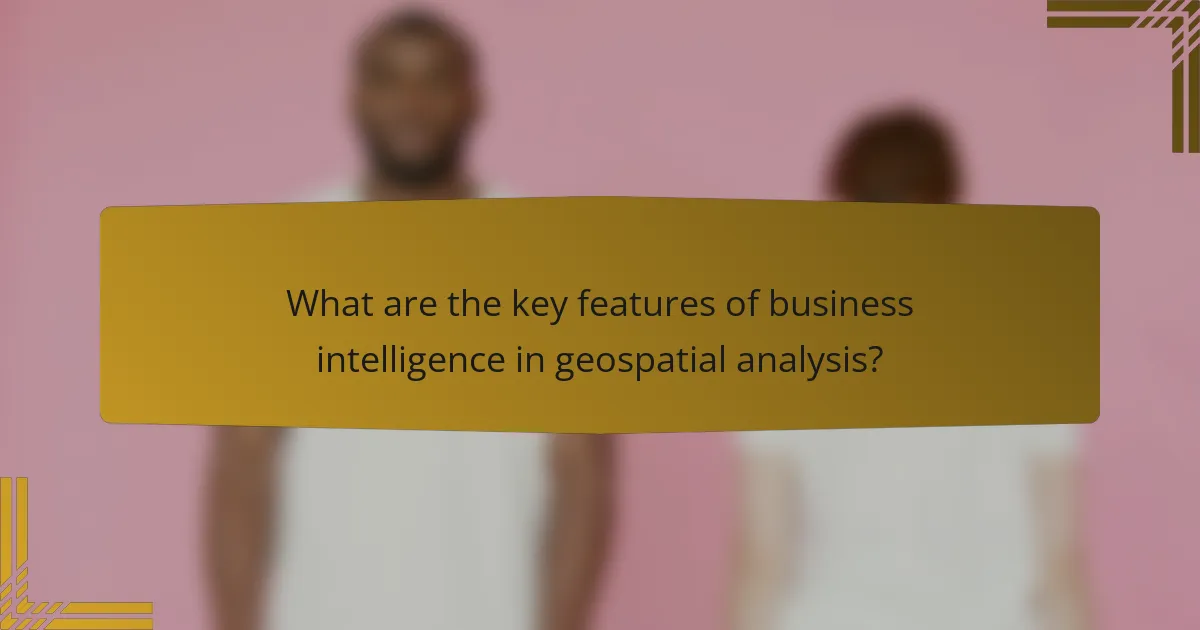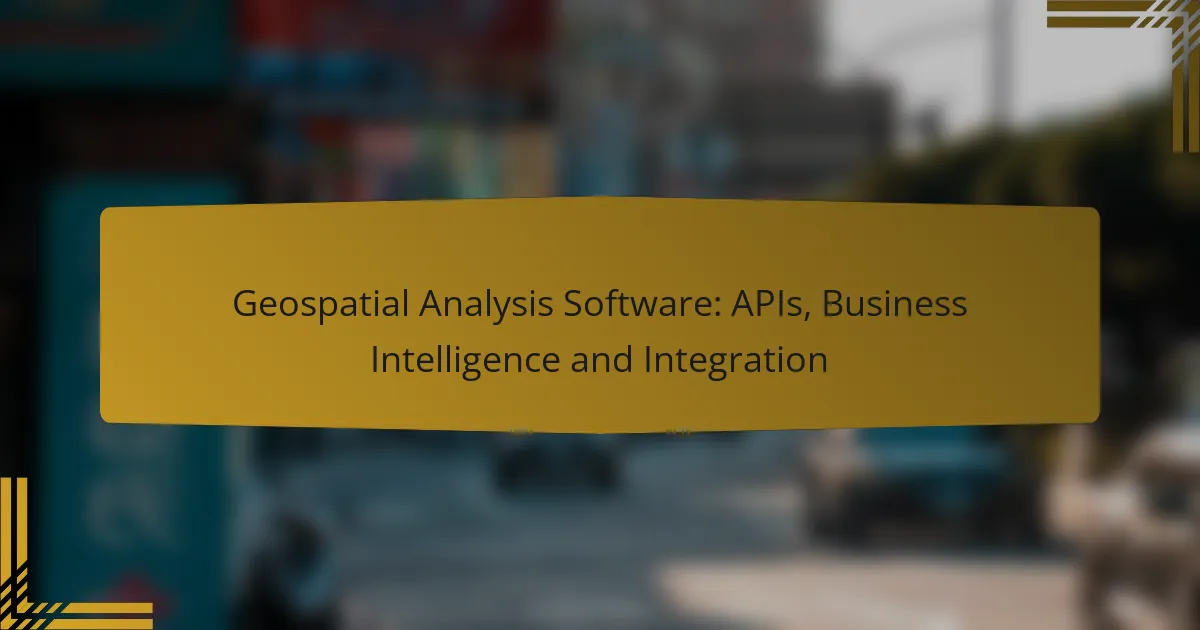Geospatial analysis software plays a crucial role in helping businesses leverage geographic data for informed decision-making through advanced mapping, visualization, and spatial analysis tools. By integrating APIs, these solutions enhance functionality, allowing for real-time data processing and customized applications tailored to specific business needs. With features that support predictive analytics and comprehensive reporting, organizations can gain valuable insights from spatial data to drive strategic initiatives.

What are the best geospatial analysis software solutions for businesses?
The best geospatial analysis software solutions for businesses include tools that provide robust mapping, data visualization, and spatial analysis capabilities. These tools help organizations make informed decisions by analyzing geographic data effectively.
ArcGIS Online
ArcGIS Online is a cloud-based platform that allows businesses to create, share, and analyze geographic information. It offers a comprehensive suite of tools for mapping and spatial analysis, making it suitable for various industries, including urban planning and environmental management.
Consider its extensive library of basemaps and ready-to-use data layers, which can enhance your projects significantly. However, be aware of the subscription costs, which can vary based on the features and user count.
QGIS
QGIS is an open-source desktop application that provides powerful geospatial analysis capabilities without licensing fees. It supports a wide range of vector and raster formats, making it versatile for different data types.
While QGIS has a steep learning curve, its active community and extensive documentation can help users overcome challenges. Businesses should consider investing time in training to maximize its potential.
Mapbox
Mapbox is a platform focused on customizable mapping solutions, ideal for businesses needing tailored visualizations. It offers APIs that allow developers to integrate maps into applications seamlessly.
Mapbox is particularly strong in mobile and web applications, providing high-quality, interactive maps. However, users should monitor usage limits and costs associated with API calls to avoid unexpected expenses.
Google Earth Engine
Google Earth Engine is a powerful cloud-based platform designed for large-scale geospatial analysis. It enables users to process vast amounts of satellite imagery and geospatial data efficiently.
This tool is particularly beneficial for environmental monitoring and research, but businesses should be aware of data privacy considerations and the need for technical expertise to leverage its full capabilities.
Carto
Carto is a location intelligence platform that specializes in data visualization and spatial analytics. It provides tools for creating interactive maps and performing complex analyses, making it suitable for marketing and logistics applications.
Businesses can benefit from Carto’s user-friendly interface and integration with various data sources. However, pricing can escalate with advanced features, so it’s essential to evaluate your needs before committing to a plan.

How do APIs enhance geospatial analysis software?
APIs significantly enhance geospatial analysis software by enabling seamless integration of diverse data sources, facilitating real-time data processing, and allowing for custom application development. This flexibility allows organizations to tailor their geospatial solutions to meet specific business needs and improve decision-making.
Data integration capabilities
APIs provide robust data integration capabilities by allowing geospatial software to connect with various data sources, such as databases, cloud services, and third-party applications. This connectivity enables users to aggregate and analyze data from multiple platforms, enhancing the depth and accuracy of geospatial insights.
For example, a business can integrate customer location data from a CRM system with geographic information from a mapping service. This integration helps in visualizing customer distribution and optimizing service delivery routes.
Real-time data processing
Real-time data processing is another critical benefit of APIs in geospatial analysis software. APIs facilitate the continuous flow of data, allowing users to receive and analyze information as it becomes available. This capability is essential for applications that require timely decision-making, such as disaster response or traffic management.
For instance, a transportation company can use APIs to gather live traffic data and adjust delivery routes instantly, reducing delays and improving efficiency. This responsiveness can lead to significant cost savings and enhanced service levels.
Custom application development
APIs enable custom application development, allowing organizations to create tailored geospatial solutions that meet their unique requirements. Developers can leverage APIs to build applications that incorporate specific functionalities, such as advanced analytics or user-friendly interfaces.
For example, a local government might develop a custom application using APIs to visualize zoning regulations and land use data, making it easier for citizens to access important information. This customization enhances user engagement and improves the overall effectiveness of geospatial tools.

What are the key features of business intelligence in geospatial analysis?
Key features of business intelligence in geospatial analysis include the ability to visualize data geographically, perform predictive analytics, and generate comprehensive reports. These capabilities enable organizations to make informed decisions based on spatial data insights.
Data visualization tools
Data visualization tools in geospatial analysis allow users to create maps and charts that represent spatial information clearly. These tools often include interactive features, enabling users to explore data layers, zoom in on specific areas, and filter information based on various criteria.
Popular visualization tools include GIS software like ArcGIS and QGIS, which provide extensive functionalities for mapping and analyzing geographic data. When selecting a tool, consider factors such as ease of use, integration capabilities, and the specific visualization needs of your project.
Predictive analytics
Predictive analytics in geospatial analysis involves using historical data and statistical algorithms to forecast future trends and behaviors. This feature helps organizations anticipate changes in patterns, such as customer movements or environmental impacts, based on spatial data.
Implementing predictive analytics typically requires a robust dataset and appropriate modeling techniques. Tools like R and Python libraries can assist in building predictive models, allowing businesses to leverage geospatial data for strategic planning and risk management.
Geospatial data reporting
Geospatial data reporting focuses on summarizing and presenting spatial information in a clear and actionable format. Effective reports can include maps, graphs, and tables that highlight key findings and trends derived from geospatial analysis.
When creating reports, ensure they are tailored to the audience’s needs, emphasizing relevant insights and actionable recommendations. Utilizing automated reporting tools can streamline the process, making it easier to generate regular updates and share findings with stakeholders.

How to choose the right geospatial analysis software?
Choosing the right geospatial analysis software involves evaluating its integration capabilities, user interface, and pricing models. These factors will help ensure the software meets your specific needs and enhances your business intelligence efforts.
Assess integration capabilities
Integration capabilities are crucial for ensuring that geospatial analysis software can work seamlessly with your existing systems. Look for software that supports APIs and can connect with popular business intelligence tools like Tableau or Power BI.
Consider whether the software can integrate with databases and other data sources you use, such as SQL databases or cloud storage solutions. A flexible integration approach can save time and reduce data silos.
Evaluate user interface
A user-friendly interface is essential for maximizing productivity and minimizing training time. Look for software that offers intuitive navigation and clear visualizations, making it easier for users to interpret geospatial data.
Consider testing the software through demos or trial versions to assess how well it aligns with your team’s workflow. A good interface should facilitate quick access to tools and features without overwhelming users.
Consider pricing models
Pricing models for geospatial analysis software can vary widely, from subscription-based to one-time licensing fees. Evaluate your budget and consider the total cost of ownership, including potential add-ons or support services.
Some software may offer tiered pricing based on features or user count, so assess which model best fits your organization’s needs. Always compare the value offered against the price to ensure you’re making a cost-effective decision.

What are the integration options for geospatial analysis software?
Geospatial analysis software offers various integration options that enhance its functionality and usability. These options typically include APIs, data connectors, and business intelligence tools that facilitate seamless data exchange and analysis.
APIs for Geospatial Analysis
APIs (Application Programming Interfaces) are essential for integrating geospatial analysis software with other applications. They allow developers to access geospatial data and functionalities programmatically, enabling custom solutions tailored to specific business needs.
Common API types include RESTful APIs and Web Map Services (WMS). RESTful APIs are widely used for their simplicity and compatibility with web technologies, while WMS provides standardized methods for serving geospatial data over the internet.
Business Intelligence Integration
Integrating geospatial analysis software with business intelligence (BI) tools enhances data visualization and decision-making. This integration allows organizations to overlay geospatial data on traditional BI dashboards, providing deeper insights into patterns and trends.
Popular BI tools like Tableau and Power BI offer native support for geospatial data, enabling users to create maps and spatial analyses directly within their reports. This integration can significantly improve the interpretability of data by adding a spatial context.
Data Connectors and ETL Tools
Data connectors and ETL (Extract, Transform, Load) tools are crucial for importing and exporting geospatial data between systems. These tools facilitate the movement of large datasets, ensuring that geospatial analysis software has access to the most current information.
Examples of ETL tools include Talend and Apache Nifi, which can automate data workflows and support various data formats. When selecting a data connector, consider compatibility with your existing systems and the volume of data you need to process.
